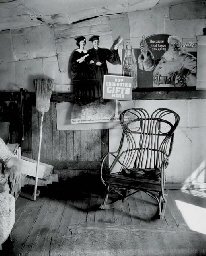The front gallery functions as a highlights section with very famous works. This review focuses on one wall of that first room.

Upon entering the room, the first print is Winston O. Link's "Hotshot Eastbound, Iager, West Virginia. It is a picture of a drive-in, with a couple snuggling in a convertible in the foreground, other cars, the screen on which a military jet airplane is shown, and in the background the train going by. Anyone who has tried night-time photography immediately realizes this is expertly lit.
Link did it with flash bulbs, strung like Christmas tree lights, hundreds of them. He had one chance to get this shot right. It took days to get the bulbs in place. He covered his back by setting up several cameras on tripods, with the help of his assistant, to make certain he got the shot.
The photographer worked for the railroad, and in this image, we see literally a plane, automobiles and a train. The three major modes of human transportation integrated into one image. The trains were falling in popularity at the time and this photograph showed that they were contemporary and viable means of transport coexisting at the time.

"The Steerage", by Alfred Stieglitz, is one of the best-known photographs in the medium's history. It was taken on an ocean liner on its way to Europe in 1907. He was at the height of his powers, 43 years old. The people at the lower level had attempted to emigrate to the US, and been rejected, forced to turn back home. At the height of his powers, Stieglitz empathized with the people below, but it was from the distance of the well-to-do. He remarked that this image represented the break with Pictorialism. He had no means to develop it aboard. Upon landing, anxious and eager, he sought out a photography studio, introduced himself, and asked if he could use the darkroom. He had brought his own developer! The result is what is referred to as the first Modernist photograph.
Nearly four decades later, when the money was gone, he was living in a room with few visitors, and he had sold remaining issues of Camera Work to a ragpicker, Stieglitz visited an antique shop, and there hung a beautifully framed gravure print of "The Steerage". he no longer had any of his own. He asked the dealer how much, and he calculated that he would have to go hungry for eight days to buy it. He didn't.
Lewis Hine had a humanitarian mission. He was showing the miserable lives of American children working adult factory jobs. He took many of girls spinning cotton in the 30's. This one (which I was unable to find on the web) is a close-up of the arms and torso of one of these workers threading a machine. She is anonymous, there's no location given, but the thread is like the narrative of history. The future being spun. Hine would go on to document the building of the Empire State. He was instrumental in getting Child Labor Laws. He worked without permission, just looking around, and illegally trespassing into factories and photographing fast. He has a thread connecting him to this area.
That is one image of cigar roller boys taken in Tampa. He was here.

"Scott's Run, West Virginia. Coal Miner's house" 1936, by Walker Evans. A pivotal photographer best-known for the work he did for the WPA during the Depression. Roy Striker needed to sell the idea of the WPA and he needed photographs to convince a skeptical nation that farm aid was essential. He was very astute hiring many of the best and brightest American documentarians of the day. Walker Evans, who thanks to Berenice Abbott had seen Atget's prints and was holding that fire (one that continues to this very day), was ready. He and writer James Agee would get lists of things to photograph, and a coal miner's house was on that list. It looks so poor, so humble, clean and orderly, but in reality, it wasn't.
Evans swept it out, rearranged the furniture and more, making it look as dignified as he possibly could. The people that lived there desperately needed the aid, and he did his very best to make sure they got it, while making a magnificent photograph through his aesthetic.
Paul Strand, "The Lusetti Family", Luzzara, Italy, 1953. Strand was an accomplished photographer at the core of American Modernism. Close to Stieglitz. His wife, Rebecca, had an affair with Georgia O'Keefe in the American West by the time he took this photograph. The planes in this picture, the way people are locked into the geometry in the background, are all classic Modernist tropes. Strand was in Italy as an exile from the USA. Two years before this picture was taken, an outstanding photographic organization/collective in New York City was viciously destroyed by the House of Unamerican Activities. The photographer members, Margaret Bourke-White, Strand, Gene Smith, Helen Levitt, Arthur Rothstein, The Newhalls, Avedon, Weegee, Robert Frank, Ansel Adams, Edwar Weston, Minor White and many of the best and brightest in the medium at the time, were humiliated, persecuted by the FBI, and it disbanded. Corporations grabbed some of the photographers for magazine work. Strand left. This is one of the photographs he made during his exile.
All these photographs are on one wall in the front room of this fantastic exhibit. Photographs are coded with culture/time/space/ and more stamps. At the time(s) of these images, the medium was white-hot. These are not isolated moments, but a loop in a vast quilt of human history.
See this show at the Museum of Fine Arts, Saint Peterburg, Florida.
255 Beach Drive
This show closes on October 4th, 2015.
mmm
No comments:
Post a Comment